Hydrogen-Free Diamond Like Carbon Films with Embedded Cu Nanoparticles: Structure, Composition and Reverse Saturable Absorption Effect
Abstract
1. Introduction
2. Materials and Methods
3. Results
4. Conclusions
Supplementary Materials
Author Contributions
Funding
Acknowledgments
Conflicts of Interest
References
- Robertson, J. Diamond-like amorphous carbon. Mater. Sci. Eng. R 2002, 37, 129–281. [Google Scholar] [CrossRef]
- Casiraghi, C.; Robertson, J.; Ferrari, A.C. Diamond-like carbon for data and beer storage. Mater. Today 2007, 10, 44–53. [Google Scholar] [CrossRef]
- Robertson, J. Comparison of diamond-like carbon to diamond for applications. Phys. Stat. Sol. (a) 2008, 205, 2233–2244. [Google Scholar] [CrossRef]
- Tyagi, A.; Walia, R.S.; Murtaza, Q.; Pandey, S.M.; Tyagi, P.K.; Bajaj, B. A critical review of diamond like carbon coating for wear resistance applications. Int. J. Refract. Met. Hard Mater. 2019, 78, 107–122. [Google Scholar] [CrossRef]
- Tamulevičius, S.; Meškinis, Š.; Tamulevičius, T.; Rubahn, H.-G. Diamond like carbon nanocomposites with embedded metallic nanoparticles. Rep. Prog. Phys. 2018, 81, 024501. [Google Scholar] [CrossRef]
- Al Mahmud, K.A.H.; Kalam, M.A.; Masjuki, H.H.; Mobarak, H.M.; Zulkifli, N.W.M. An updated overview of diamond-like carbon coating in tribology. Crit. Rev. Solid State Mater. Sci. 2015, 40, 90–118. [Google Scholar] [CrossRef]
- Cheng, C.-H.; Lin, Y.; Chen, T.; Chen, H.; Chi, Y.; Lee, C.; Wu, C.; Lin, G. Can silicon carbide serve as a saturable absorber for passive mode-locked fiber lasers? Sci. Rep. 2016, 5, 16463. [Google Scholar] [CrossRef]
- Meškinis, Š.; Vasiliauskas, A.; Andrulevičius, M.; Jurkevičiūtė, A.; Peckus, D.; Kopustinskas, V.; Viskontas, K.; Tamulevičius, S. Self-Saturable Absorption and Reverse-Saturable Absorption Effects in Diamond-Like Carbon Films with Embedded Copper Nanoparticles. Coatings 2019, 9, 100. [Google Scholar] [CrossRef]
- Hader, J.; Yang, H.-J.; Scheller, M.; Moloney, J.V.; Koch, S.W. Microscopic analysis of saturable absorbers: Semiconductor saturable absorber mirrors versus graphene. J. Appl. Phys. 2016, 119, 053102. [Google Scholar] [CrossRef]
- Kang, Z.; Li, Q.; Gao, X.J.; Zhang, L.; Jia, Z.X.; Feng, Y.; Qin, G.S.; Qin, W.P. Gold nanorod saturable absorber for passive mode-locking at 1 μm wavelength. Laser Phys. Lett. 2014, 11, 035102. [Google Scholar] [CrossRef]
- Elim, H.I.; Yang, J.; Lee, J.-Y.; Mi, J.; Ji, W. Observation of saturable and reverse-saturable absorption at longitudinal surface plasmon resonance in gold nanorods. Appl. Phys. Lett. 2006, 88, 083107. [Google Scholar] [CrossRef]
- Chernysheva, M.; Rozhin, A.; Fedotov, Y.; Mou, C.B.; Arif, R.; Kobtsev, S.M.; Dianov, E.M.; Turitsyn, S.K. Carbon nanotubes for ultrafast fibre lasers. Nanophotonics 2017, 6, 1–30. [Google Scholar] [CrossRef]
- Cui, W.G.; Lai, Q.B.; Zhang, L.; Wang, F.M. Quantitative measurements of sp3 content in DLC films with Raman spectroscopy. Surf. Coat. Technol. 2010, 205, 1995–1999. [Google Scholar] [CrossRef]
- Viskontas, K.; Rusteika, N. All-fiber wavelength-tunable picosecond nonlinear reflectivity measurement setup for characterization of semiconductor saturable absorber mirrors. Opt. Fiber Technol. 2016, 31, 74–82. [Google Scholar] [CrossRef]
- Jia, Z.; Li, C.; Liu, D.; Jiang, L. Direct hydrothermal reduction of graphene oxide based papers obtained from tape casting for supercapacitor applications. RSC Adv. 2015, 5, 81030–81037. [Google Scholar] [CrossRef]
- Laufer, A.; Reppin, D.; Metelmann, H.; Geburt, S.; Ronning, C.; Leichtweiss, T.; Janek, J.; Meyer, B.K. Quantification of impurity concentration in Cu2O and CuO via secondary ion mass spectrometry. Phys. Status Solidi B 2012, 249, 801–811. [Google Scholar] [CrossRef]
- Moulder, J.F.; Stickle, W.F.; Sobol, P.E.; Bomben, K.D. Handbook of X-ray Photoelectron Spectroscopy; Chastain, J., Ed.; Perkin-Elmer Corp: Eden Prairie, MN, USA, 1992. [Google Scholar]
- Evans, S. Energy calibration secondary standards for X-ray photoelectron spectrometers. Surf. Interface Anal. 1985, 7, 299–302. [Google Scholar] [CrossRef]
- Gerhards, I.; Ronning, C.; Vetter, U.; Hofsass, H.; Gibhardt, H.; Eckold, G.; Li, Q.; Lee, S.T.; Huang, Y.L.; Seibt, M. Ion beam synthesis of amorphous carbon thin films containing metallic nanoclusters. Surf. Coat. Technol. 2002, 158, 114–119. [Google Scholar] [CrossRef]
- Chan, Y.H.; Huang, C.F.; Ou, K.L.; Peng, P.W. Mechanical properties and antibacterial activity of copper doped diamond-like carbon films. Surf. Coat. Technol. 2011, 206, 1037–1040. [Google Scholar] [CrossRef]
- Costa, S.D.; Righi, A.; Fantini, C.; Hao, Y.; Magnuson, C.; Colombo, L.; Ruoff, R.S.; Pimenta, M.A. Resonant Raman spectroscopy of graphene grown on copper substrates. Solid State Commun. 2012, 152, 1317–1320. [Google Scholar] [CrossRef]
- Yeshchenko, O.A.; Bondarchuk, I.S.; Losytskyy, M.Y. Surface plasmon enhanced photoluminescence from copper nanoparticles: Influence of temperature. J. Appl. Phys. 2014, 116, 054309. [Google Scholar] [CrossRef]
- Safaie, P.; Eshaghi, A.; Bakhshi, S.R. Optical properties of oxygen doped diamond-like carbon thin films. J. Alloys Compound. 2016, 672, 426–432. [Google Scholar] [CrossRef]
- Wei, X.; Muraya, N.; Yanase, T.; Nagahama, T.; Shimada, T. Diamond-like carbon doped with highly π-conjugated molecules by plasma-assisted CVD. Jpn. J. Appl. Phys. 2014, 53, 010203. [Google Scholar] [CrossRef]
- Zoubos, H.; Koutsokeras, L.E.; Anagnostopoulos, D.F.; Lidorikis, E.; Kalogirou, S.A.; Wildes, A.R.; Kelires, P.C.; Patsalas, P. Broadband optical absorption of amorphous carbon/Ag nanocomposite films and its potential for solar harvesting applications. Sol. Energy Mater. Sol. Cells 2013, 117, 350–356. [Google Scholar] [CrossRef]
- Meškinis, Š.; Čiegis, A.; Vasiliauskas, A.; Šlapikas, K.; Tamulevičius, T.; Tamulevičienė, A.; Tamulevičius, S. Optical properties of diamond like carbon films containing copper, grown by high power pulsed magnetron sputtering and direct current magnetron sputtering: Structure and composition effects. Thin Solid Films 2015, 581, 48–53. [Google Scholar]
- Jauffred, L.; Samadi, A.; Klingberg, H.; Bendix, P.M.; Oddershede, L.B. Plasmonic Heating of Nanostructures. Chem. Rev. 2019, 119, 8087–8130. [Google Scholar] [CrossRef]
- Kolpakov, A.Y.; Poplavsky, A.I.; Galkina, M.E.S.; Manokhin, S.; Gerus, J.V. The local crystallization in nanoscale diamond-like carbon films during annealing. Appl. Phys. Lett. 2014, 105, 233110. [Google Scholar] [CrossRef]
- Rose, F.; Wang, N.; Smith, R.; Xiao, Q.-F.; Inaba, H.; Matsumura, T.; Saito, Y.; Matsumoto, H.; Dai, Q.; Marchon, B.; et al. Complete characterization by Raman spectroscopy of the structural properties of thin hydrogenated diamond-like carbon films exposed to rapid thermal annealing. J. Appl. Phys. 2014, 116, 123516. [Google Scholar]
- Lee, K.; Ki, H. Rapid fabrication of transparent conductive films with controllable sheet resistance on glass substrates by laser annealing of diamond-like carbon films. Acta Mater. 2016, 111, 315–320. [Google Scholar] [CrossRef]
- Endrino, J.L.; Horwat, D.; Anders, A.; Andersson, J.; Gago, R. Impact of Annealing on the Conductivity of Amorphous Carbon Films Incorporating Copper and Gold Nanoparticles Deposited by Pulsed Dual Cathodic Arc. Plasma Process. Polym. 2009, 6, S438–S443. [Google Scholar] [CrossRef]
- Yaremchuk, I.; Meškinis, Š.; Bulavinets, T.; Vasiliauskas, A.; Andrulevičius, M.; Fitio, V.; Bobitski, Y.; Tamulevičius, S. Effect of oxidation of copper nanoparticles on absorption spectra of DLC:Cu nanocomposites. Diamond Relat. Mater. 2019, 99, 107538. [Google Scholar] [CrossRef]
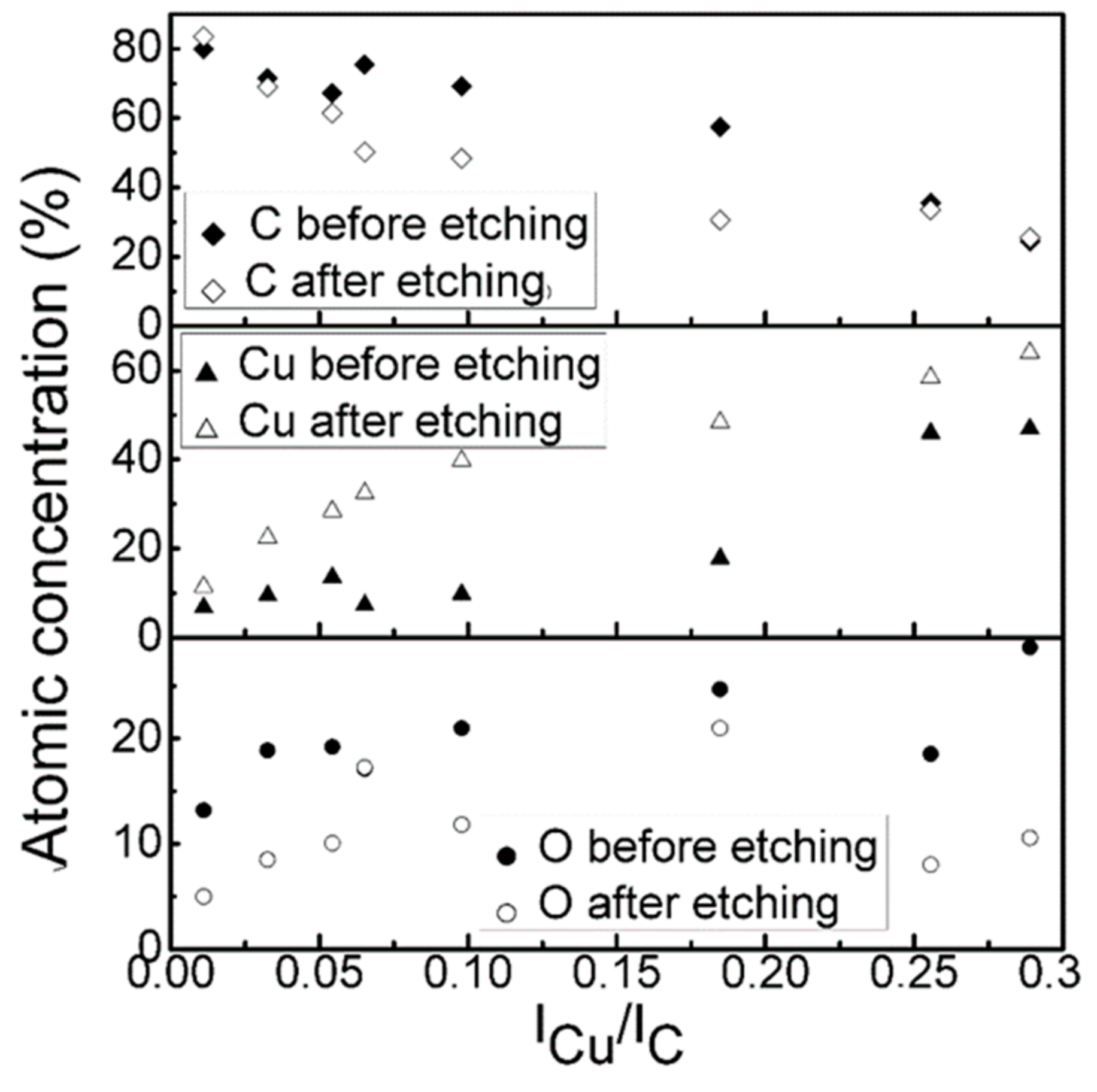
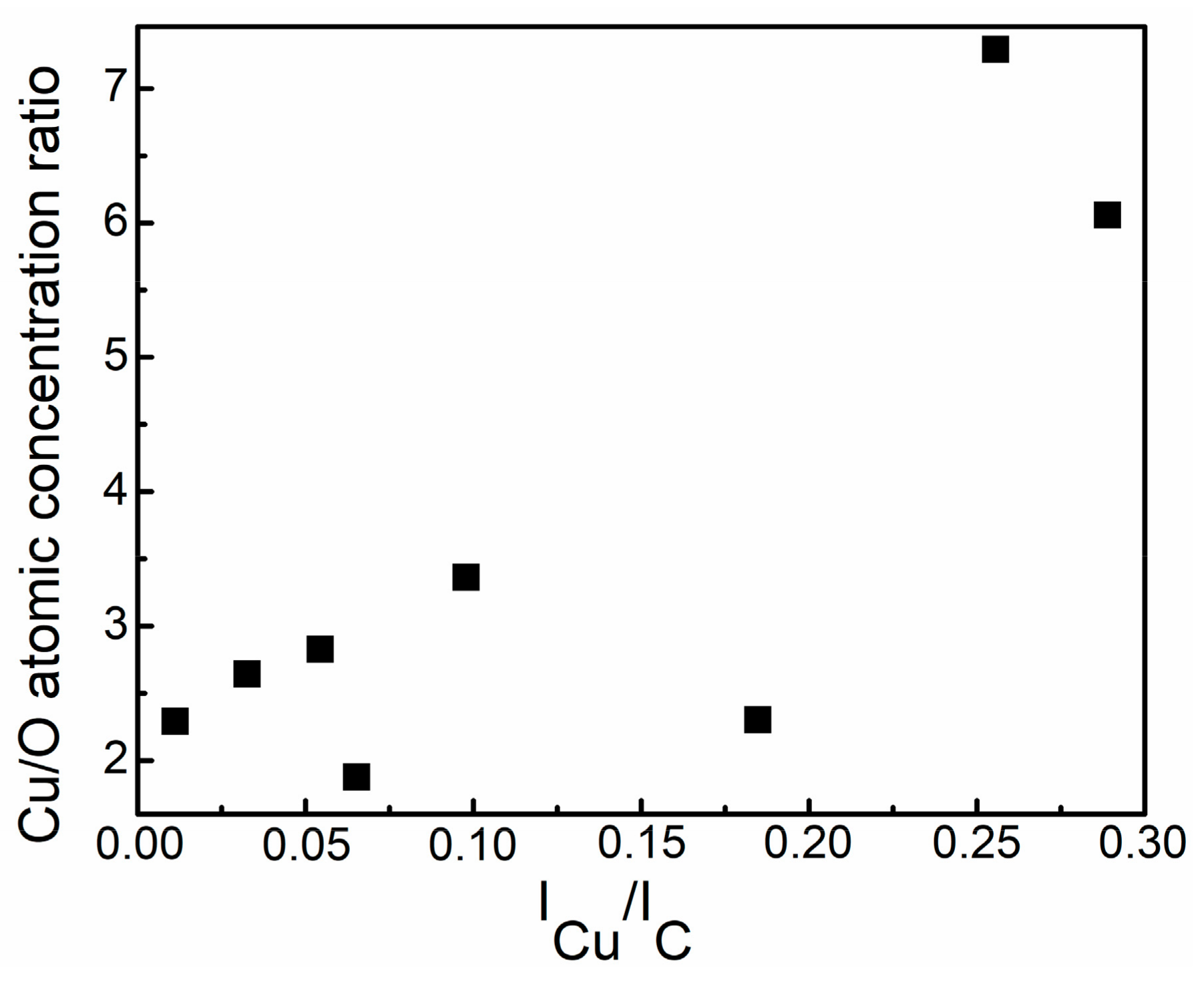

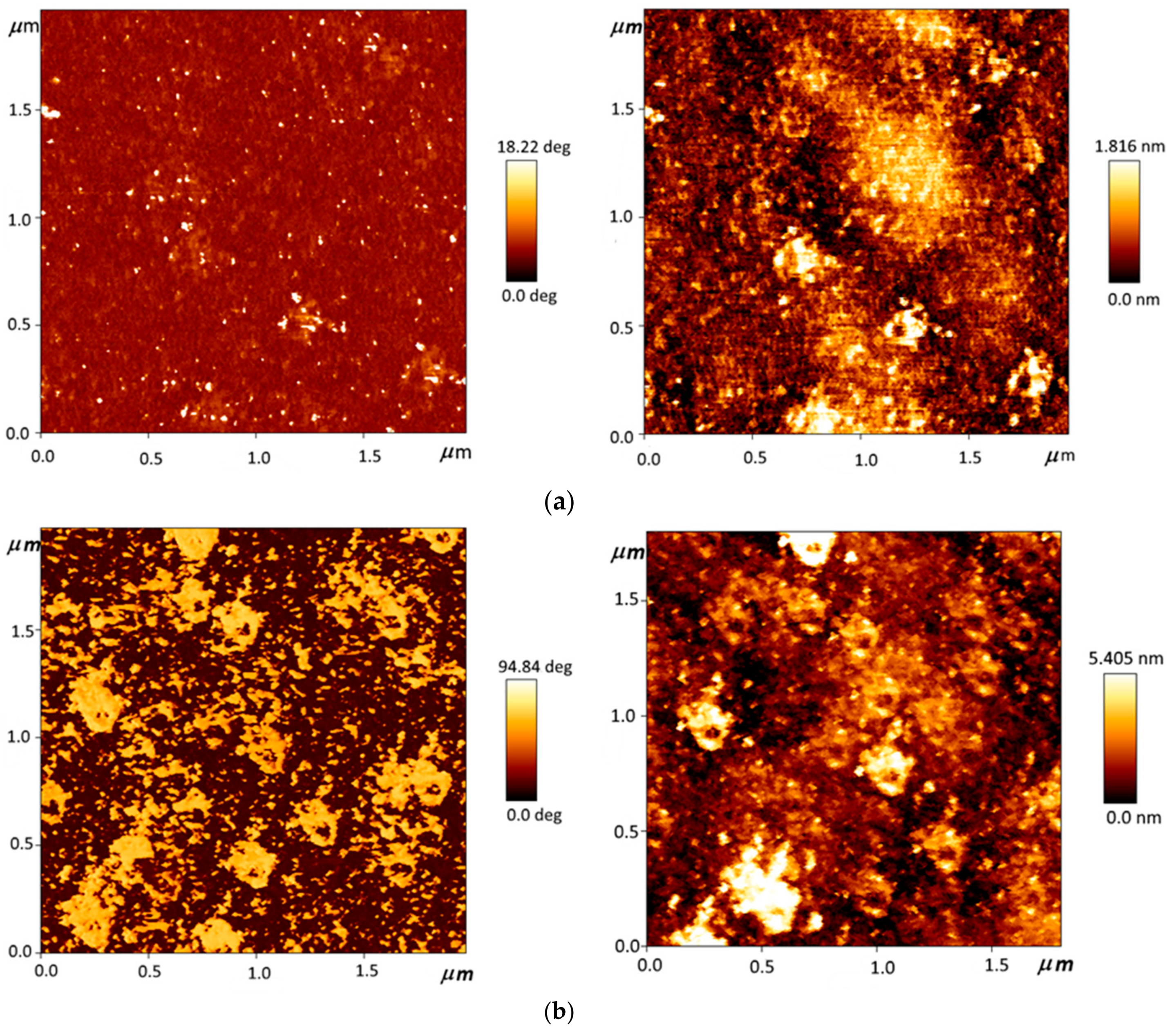
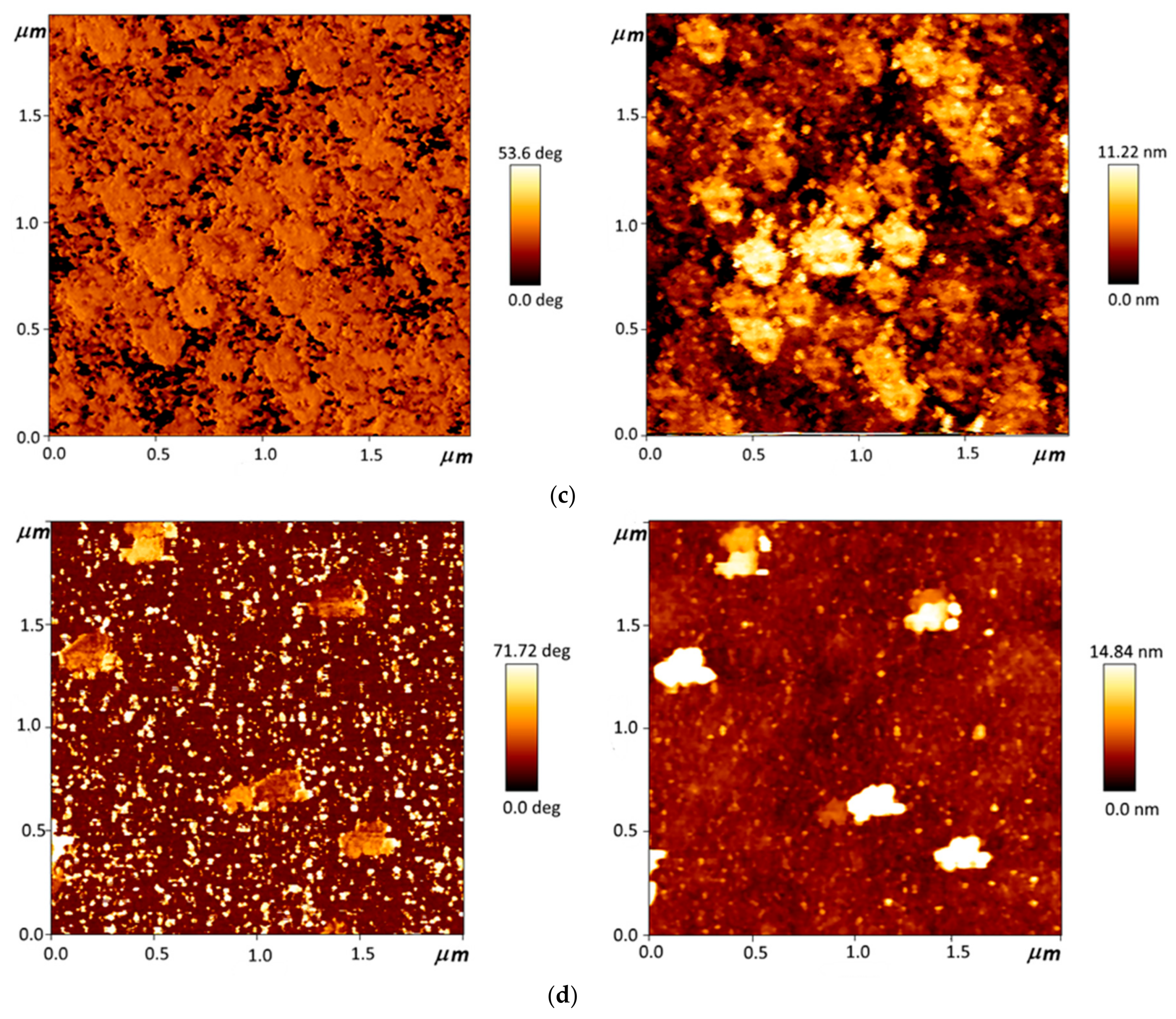
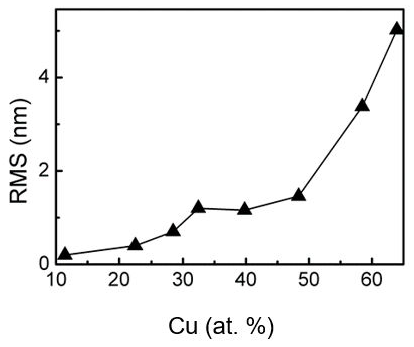
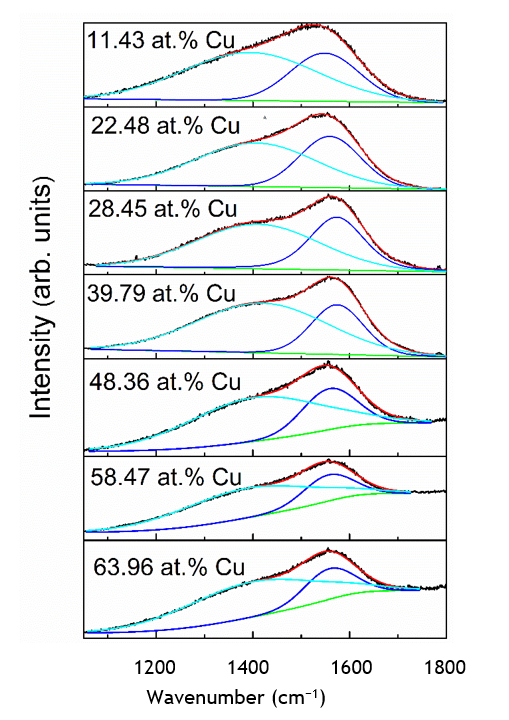
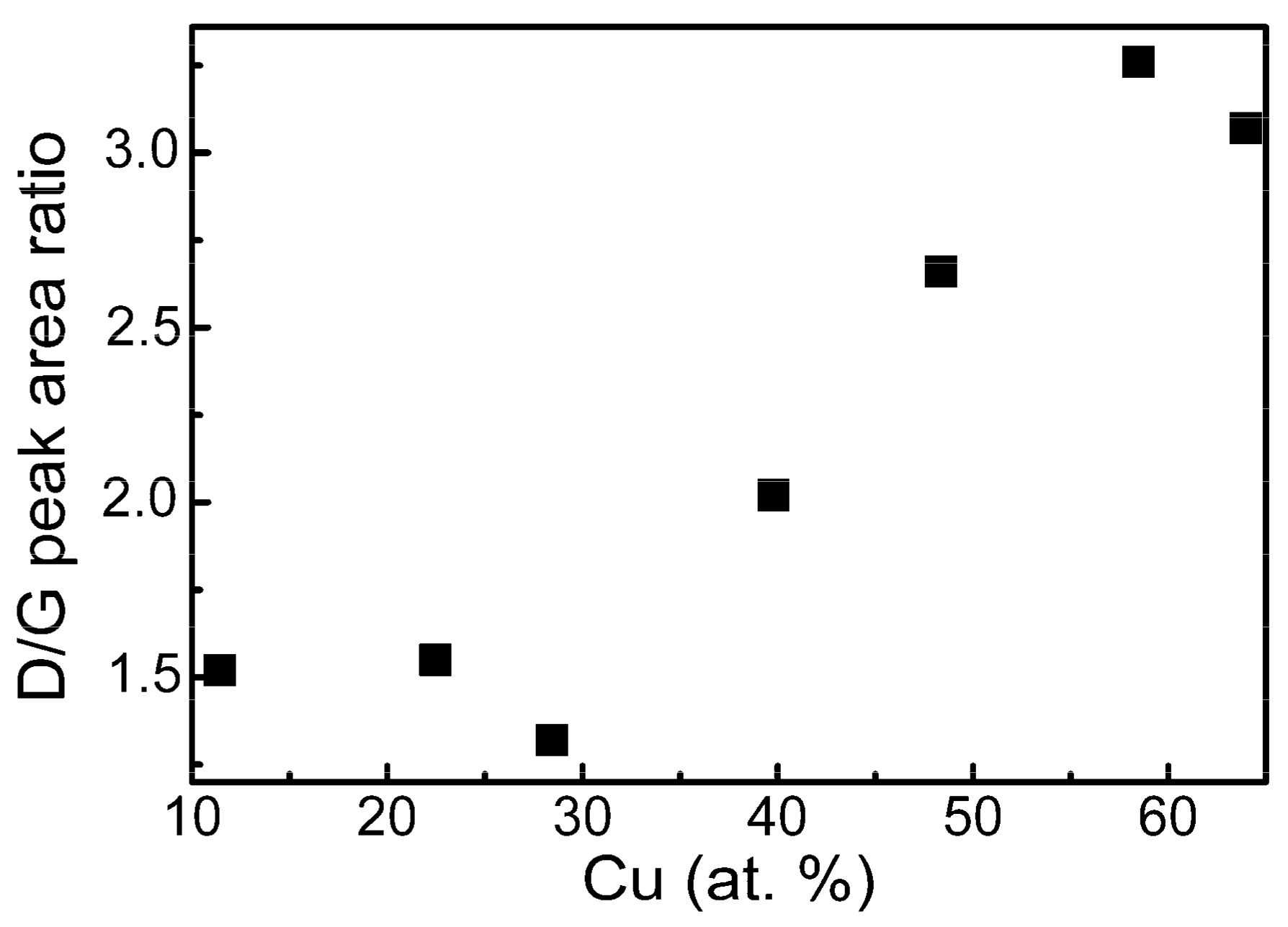
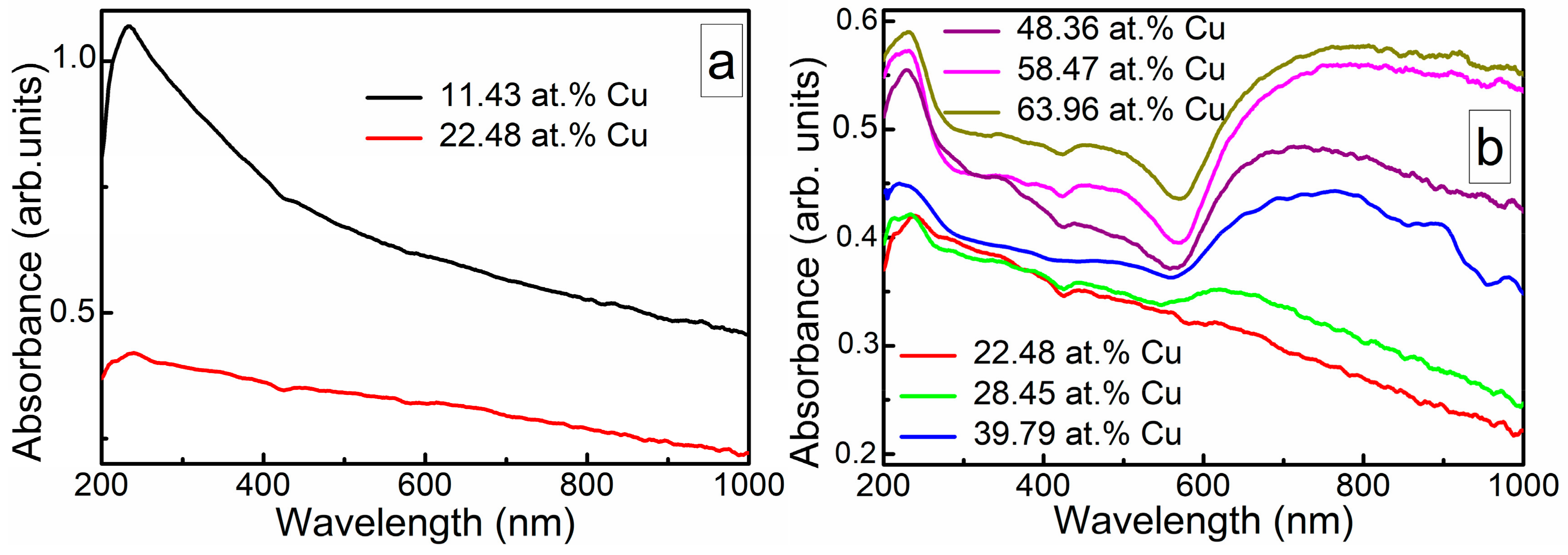

| Sample No | Current (A) | Ar Gas Flow (sccm) | Voltage (V) | |||
|---|---|---|---|---|---|---|
| Cu Target | C Target | Cu Target | C Target | Cu Target | C Target | |
| Cu01 | 0.01 | 0.9 | 56 | 49 | 285 | 732 |
| Cu03 | 0.03 | 0.9 | 56 | 49 | 295 | 729 |
| Cu05 | 0.05 | 0.91 | 56 | 49 | 299 | 723 |
| Cu06 | 0.06 | 0.92 | 56 | 49 | 303 | 722 |
| Cu09 | 0.09 | 0.92 | 56 | 49 | 309 | 718 |
| Cu17 | 0.17 | 0.9 | 56 | 49 | 324 | 728 |
| Cu25 | 0.25 | 0.9 | 56 | 49 | 330 | 704 |
| Cu35 | 0.35 | 0.9 | 56 | 49 | 331 | 705 |
| Surface Morphology and Phase Structure According to AFM | Main Features of Optical Absorbance Spectra |
|---|---|
| Ultrasmooth DLC:Cu film (RMS = 196 pm). Some solitary point-like structures can be seen in phase image | Absorption spectra typical for undoped DLC. |
| Agglomeration of the point structures to the aggregates. RMS of the films slightly increase. | Significant decrease of the light absorbance in lower wavelengths range. |
| Increased number of the observed clusters. Significant increase of the RMS (5 times). | Appearance of the weak plasmonic peak. |
| Secondary point structures and nanoclusters formation. No further increase of the RMS. | Plasmonic peak redshift and significant increase of the intensity. |
| Nanoclusters began to grow vertically and RMS increase again. | Only slight changes of the absorbance spectra. |
| Ultrasmooth DLC:Cu film (RMS = 196 pm). Some solitary point-like structures can be seen in phase image. | Absorption spectra typical for undoped DLC. |
| Agglomeration of the point structures to the aggregates. RMS of the films slightly increase. | Significant decrease of the light absorbance in lower wavelengths range. |
© 2020 by the authors. Licensee MDPI, Basel, Switzerland. This article is an open access article distributed under the terms and conditions of the Creative Commons Attribution (CC BY) license (http://creativecommons.org/licenses/by/4.0/).
Share and Cite
Meškinis, Š.; Vasiliauskas, A.; Viskontas, K.; Andrulevičius, M.; Guobienė, A.; Tamulevičius, S. Hydrogen-Free Diamond Like Carbon Films with Embedded Cu Nanoparticles: Structure, Composition and Reverse Saturable Absorption Effect. Materials 2020, 13, 760. https://doi.org/10.3390/ma13030760
Meškinis Š, Vasiliauskas A, Viskontas K, Andrulevičius M, Guobienė A, Tamulevičius S. Hydrogen-Free Diamond Like Carbon Films with Embedded Cu Nanoparticles: Structure, Composition and Reverse Saturable Absorption Effect. Materials. 2020; 13(3):760. https://doi.org/10.3390/ma13030760
Chicago/Turabian StyleMeškinis, Šarūnas, Andrius Vasiliauskas, Karolis Viskontas, Mindaugas Andrulevičius, Asta Guobienė, and Sigitas Tamulevičius. 2020. "Hydrogen-Free Diamond Like Carbon Films with Embedded Cu Nanoparticles: Structure, Composition and Reverse Saturable Absorption Effect" Materials 13, no. 3: 760. https://doi.org/10.3390/ma13030760
APA StyleMeškinis, Š., Vasiliauskas, A., Viskontas, K., Andrulevičius, M., Guobienė, A., & Tamulevičius, S. (2020). Hydrogen-Free Diamond Like Carbon Films with Embedded Cu Nanoparticles: Structure, Composition and Reverse Saturable Absorption Effect. Materials, 13(3), 760. https://doi.org/10.3390/ma13030760





